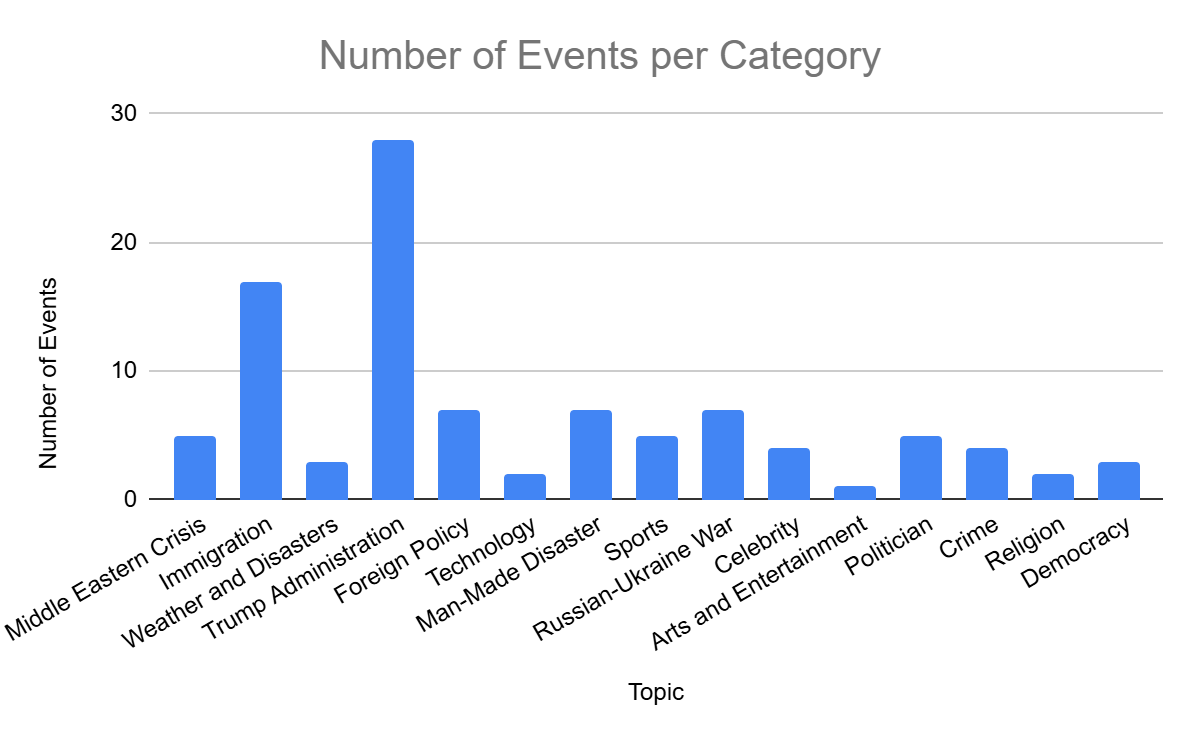Worried about the Russians dividing America? The call is coming from inside the house
By Jennifer Allen
Alarming coverage of Russian propaganda masks a closer threat: inflammatory rhetoric from domestic media and pundits
Another election, another Russian disinformation scandal. According to recent reports, Russia has moved beyond fake news and troll networks to propping up inflammatory domestic media. Two Russian nationals were indicted for covertly funding and directing the Tenet Media, a Tennessee-based company which used plausibly unwitting conservative influencers to push Russia-backed narratives. The influencers claim they were unaware of the Russian backing and had “full editorial control”, although the Justice Department outlines at least one instance where a commentator supposedly agreed to cover a story with an anti-Ukraine, anti-US angle at the founder’s request.
The Tenet Media example is the latest in a long string of Russian attempts to influence American public opinion. In this instance, the goal of the campaign was to push Russian talking points and “amplify domestic divisions in the United States.” But although we should certainly condemn a foreign adversary’s attempts to divide the American populace, we shouldn’t assume that these attempts are necessarily successful. Or at least, more successful at dividing the American populace than domestic media.
How should we define “success” for Russian propaganda? Quantifying influence is tricky, but our recent Science paper offers a potential framework. The idea is that in order to be broadly impactful, an influence campaign – or any other persuasive media – must satisfy two conditions: 1) it must be widely seen and 2) when seen, it has to affect target attitudes and behavior. While the framework doesn’t capture every facet of impact – e.g. cases where a single individual is radicalized to violence, or the indirect impact of Russian disinformation on media trust– it’s a useful heuristic for estimating population-scale media impact.
With this framework in mind, let’s assess the case of Tenet Media. To put the numbers in perspective, we’ll compare Tenet’s popularity and persuasiveness to two prominent domestic sources: Fox News and Tucker Carlson. To allow for apples-to-apples comparison, we’ll only look at the performance of these channels on YouTube (a choice which favors Tenet, since Carlson’s and Fox’s primary audiences are on X and cable, respectively.) Our analysis reveals that across the board, domestic sources were: 1) much more popular than 2) more pro-Russia than, and 3) about as polarizing as the Russian-sponsored outlet.
Putting two and two together, the data show that we don’t need Russian propaganda to divide America: we’re doing just fine on our own.
The evidence follows.
1) Russian-funded media wasn’t particularly popular – especially compared to compared to domestic partisan media
Although Tenet’s site was taken down, we were able to collect transcript data for ~800 videos they posted on YouTube (a comparison of this data with the Tenet Rumble page and the Internet Archive suggests that these transcripts covered ~all of the standard videos, but excluded the YouTube shorts). These videos received a total of 11 million views on YouTube – 68% percent of the 16 million views reported in the Justice Department affidavit. 16 million might sound like a lot, but compared to the 400 million views on Tucker Carlson’s channel and 2.2 billion views on Fox News’s channel during the same time period, it’s clear that Tenet Media was a small player.

Looking at the average number of views per video, rather than the cumulative total, Tenet’s performance is similarly unimpressive – they notched 13.8K views per video compared to Fox’s 180K and Carlson’s 706K. Yet, even these popular channels couldn’t touch the numbers from the last presidential debate. An eye-popping 67 million people watched Donald Trump spreading debunked conspiracy theories about immigrants eating pets and dodging questions about which country he supports in the Russia-Ukraine war. Although 16 million cumulative views on YouTube isn’t nothing, the Russian propaganda outlet doesn’t hold a candle to the popularity of traditional media, top pundits, and politicians.
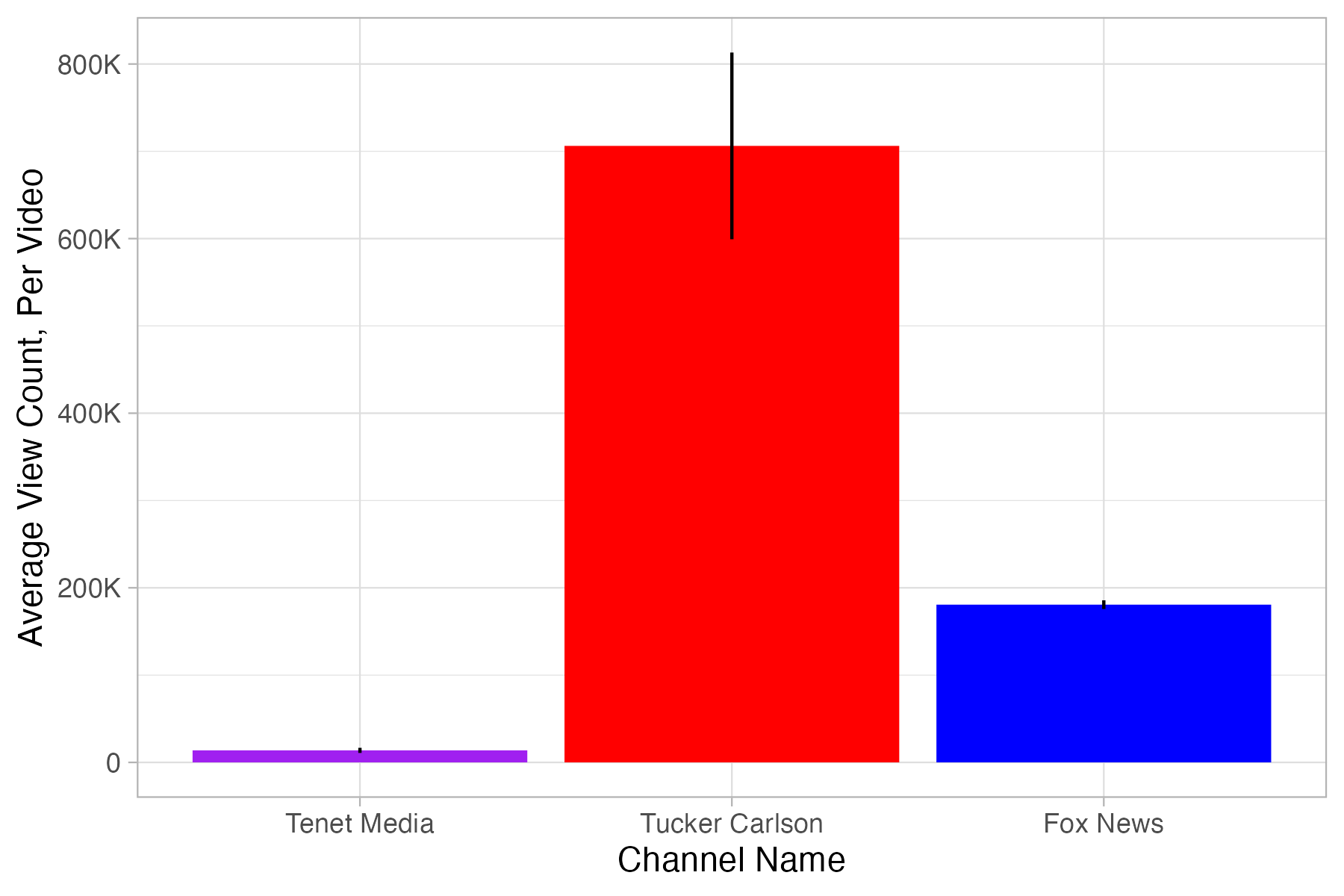
2) Pro Russian talking points didn’t feature particularly heavily on Tenet (Tucker Carlson is a different story)
Despite being funded by Russian affiliates, Tenet Media didn’t appear to engage in the kind of overt Russian propaganda of other influence campaigns. In fact, the amount of Tenet’s Russia-related coverage — and the favorability of such coverage – paled in comparison to Tucker Carlson.
To evaluate the coverage, we used the GPT-4o-mini API to analyze all 813 Tenet Media videos, 565 Tucker Carlson videos, and a random sample of 500 of the 12,079 Fox News videos (for scalability). We prompted the LLM to 1) identify transcripts that mentioned Russia or Russia-related topics (e.g. Putin, military funding for Ukraine, NATO, etc) and 2) summarize the video’s discussion of these topics. We then calculated the proportion of videos related – even tangentially – to Russia.
Of the three outlets, Tenet Media actually mentioned Russia the least – 8.1% of videos compared to 18.9% of Fox News videos or 23.5% of Tucker Carlson videos. The coverage of Russia amongst these three channels spanned a variety of topics, but particularly focused on the war in Ukraine and U.S. aid to Ukraine. Tenet did focus slightly more on the war in Ukraine than the other outlets did, but not substantially so. Ironically, while secretly funded by Russia, Tenet media spent 12% of its Russia related coverage dismissing concerns about ties between Russia and prominent conservatives as a "hoax."
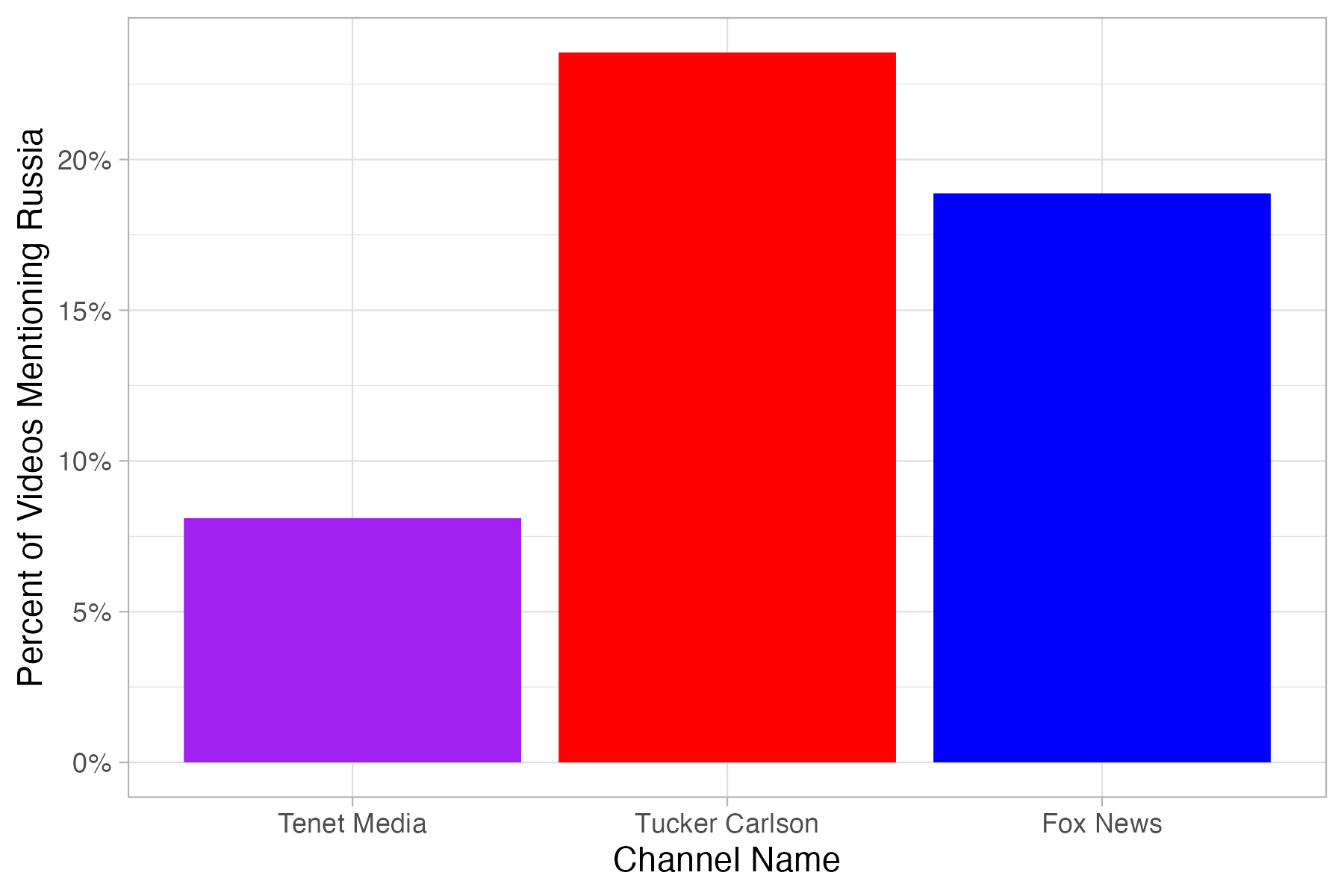

So there wasn’t much coverage – but maybe it was particularly pro-Russia? Again, we used GPT to label the stance of the videos towards Russia and Russian-interests (like ending U.S. aid to Ukraine) as being either “Pro”, “Neutral”, or “Anti.”
Most of the coverage was neutral in nature, mentioning Russia only in passing or without any particular lens. Tenet media did include some videos favoring Russian interests (e.g. videos titled “JD Vance Isn't Concerned With Ukraine” and “‘We Struggle Over Here:’ Beachgoer Is DONE With Foreign Aid”) but also included some that were critical of Russia (e.g. ridiculing Putin in a video titled “Russia Wants Alaska Back?”) Mostly, however, they didn’t cover the subject in great depth.
Instead, the data reveals the biggest spreader of pro-Russia talking points is Tucker Carlson. Carlson produced 3X as many pro-Russia videos as anti ones, including his video interviewing Putin which was viewed more than 20 million times on YouTube. While the shady funding of Tenet media certainly should raise eyebrows, Carlson is the real culprit when it comes to advancing pro-Russia, anti-Ukraine messaging to the widest audience.
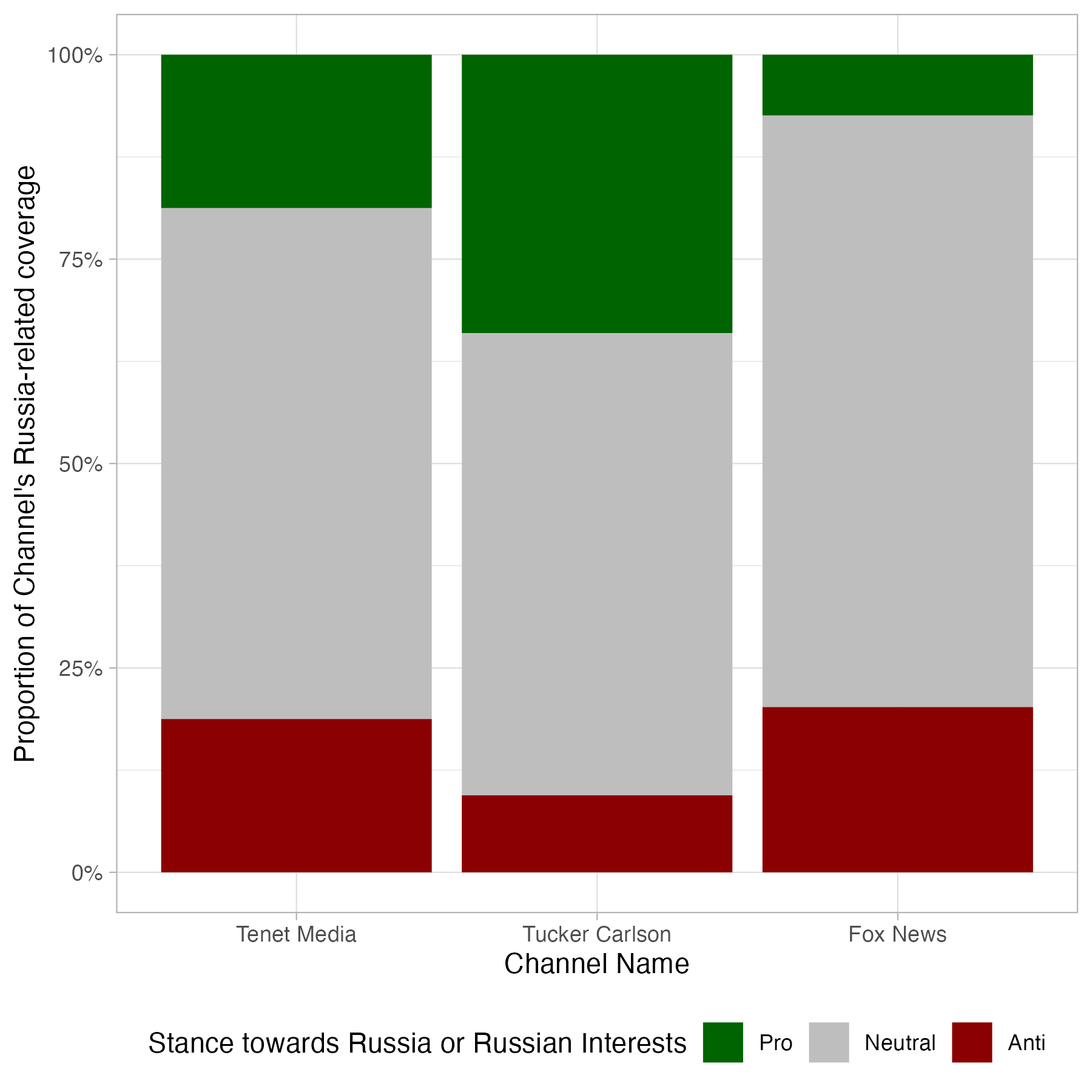
3) Tenet’s rhetoric wasn’t clearly more polarizing than domestic media
Instead of focusing on Russia-specific content, the Tenet Media influencers spent a lot of their time criticizing “woke” culture. A list of the top 10 topics covered by each of the three channels (adapted from the Bias Detector topics) shows that Tenet Media focused more on hot button culture wars issues than foreign policy. While the 2024 election was the biggest focus, other issues like Crime, Race, Immigration, Gender, and LGBTQ issues were among the top 10 issues, including videos like “Is Trad Wife Life Better, The Nature Of Women And Men” and “Correcting Grammar Is Racist, Says Teacher.”
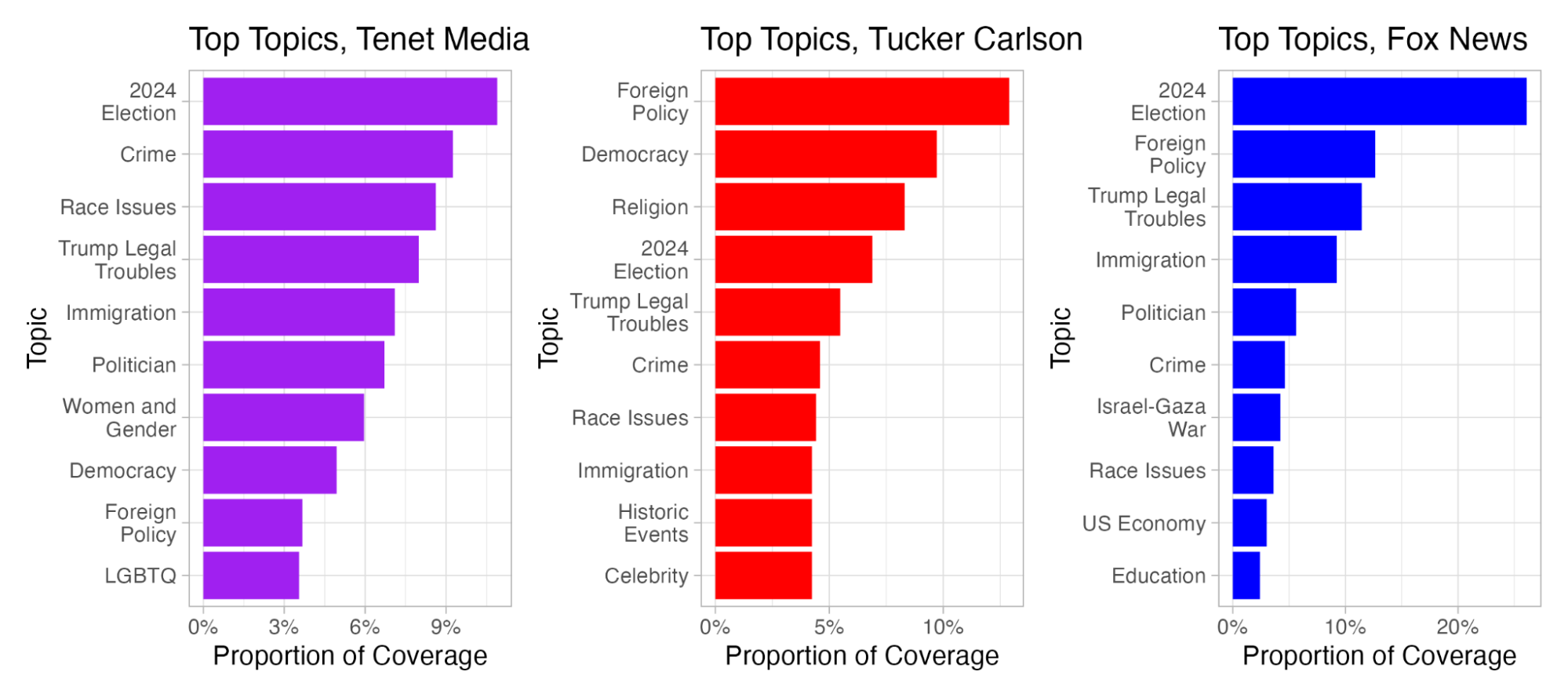
Yet, while the topical coverage differed, it’s not immediately obvious that the Tenet Media content was necessarily more polarizing than domestic coverage.
To assess how polarizing the content was, we adapted the methods from Jia et al (2024) to label each post on 8 different dimensions related to anti-Democratic attitudes and partisan animosity, and then aggregated them together to create a “Polarization Index” for each video. We scaled the index so the average score is 0, where higher values correspond to more polarizing videos. Prior work has shown a causal relationship between exposure to high-scoring posts and participants’ affective polarization towards the opposing party.
We don’t see a significant difference between the three channels’ content on the polarization index. Although it’s possible that an experiment could reveal Tenet media actually is more polarizing, perhaps along racial or gender lines, the text itself does not suggest any such thing.
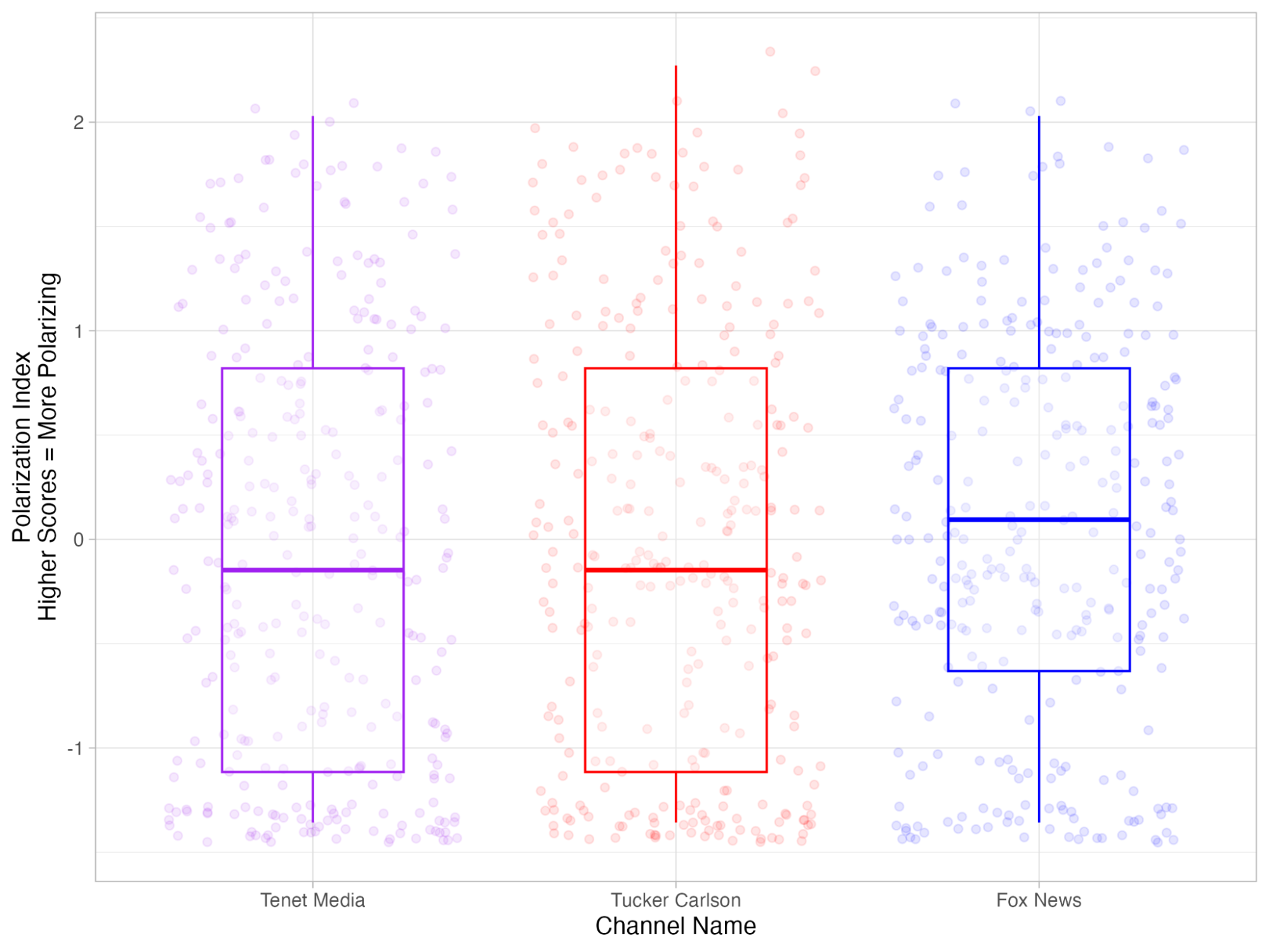
Putting it all together
The analysis shows that Russian-funded Tenet wasn’t particularly popular, pro-Russia, or polarizing compared to domestic entities. All this raises the question – what was Russia’s end game? It’s not clear. It’s possible that this was just an unsuccessful effort or they were interrupted before they could execute on a longer con. After all, in 2016, Russian-controlled social media pages built an audience using non-political content before pushing anti-democratic messages right before the election. It’s also likely that other Russian propaganda campaigns remain undetected or work through more covert influence. We shouldn’t ignore the risk of foreign propaganda distorting our democracy.
That said, we shouldn’t do the Russians’ work for them. The Justice Department affidavit summarizes the Russian’s strategy as “anything that causes chaos.” Recent work suggests that media coverage of mis and disinformation can increase overall skepticism of responsible outlets. Extensive coverage of Russian propaganda – that doesn’t contextualize its limited reach – runs the risk of playing into the Russians’ hands, while giving cover to homegrown offenders. Both are mistakes. We can condemn foreign propaganda efforts without overstating their efficacy, and we can criticize all efforts to divide our country, even if they come from within.

